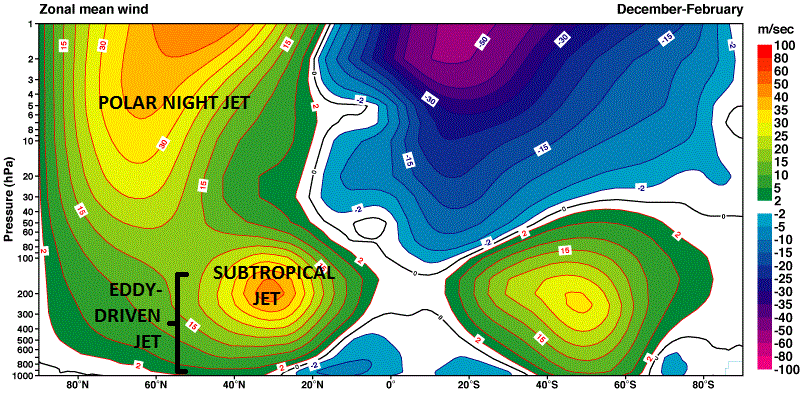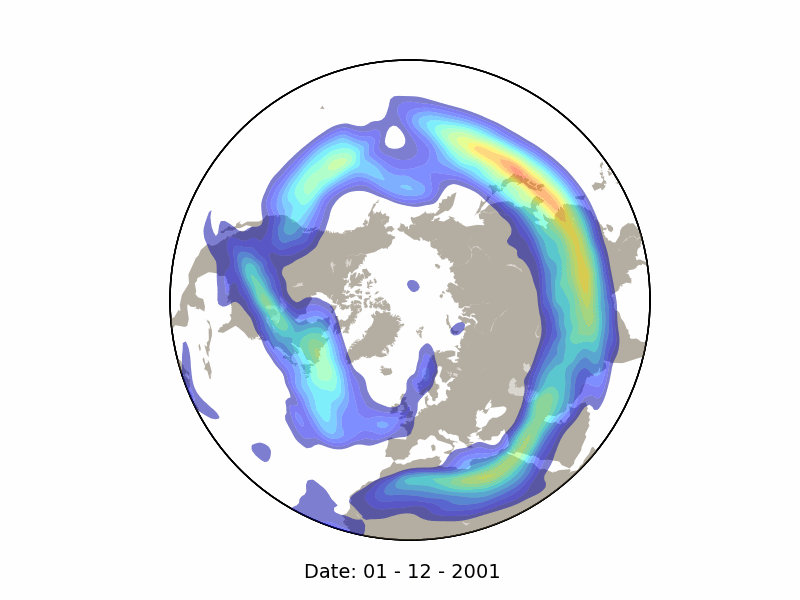Menu
Lenka Novak: Research
Background and Context
| Atmospheric jet streams are narrow currents of fast wind that are found on Earth and other planets. The Earth has three main jet streams in each hemisphere: the subtropical jet, the eddy-driven jet and the polar night jet (only occurring in the winter hemisphere). These are shown for the Northern Hemisphere in figure 1. The subtropical jet is driven by the thermally overturning circulation between the tropics and the subtropics, and it is mostly constrained near the latitude of the subtropics (i.e. 30°N and 30°S) near the tropopause. The polar night jet forms in the stratosphere around the latitude of 60° of the winter hemisphere due to the sharp meridional temperature gradients that form as the polar night begins. |

|
| Figure 1: Mean zonal wind of winters from 1957 to 2002, adapted from the ERA-40 Atlas. | |
| The formation of the eddy-driven jet (sometimes referred to as polar jet) is more complicated. Sharp meridional temperature contrasts are produced by the cold polar and warm subtropical air meeting in mid latitudes. These temperature contrasts are not zonally symmetric, but are enhanced by the presence of continents (for example, through the land-sea contrast, orography and oceanic currents). These local regions of enhanced temperature gradients (accompanied with sharp vertical shear) determine the locations of storm tracks. Storm tracks are zones of enhanced storm (thus eddy) activity and they form due to the (baroclinic) instability that is proportional to the meridional temperature gradient. Although round eddies do not induce any net meridional momentum flux, as they mature they deform and tilt with their tilting being such that they cause momentum convergence around the latitude of the storm track. This gives rise to the eddy-driven jet. It is less regular and zonally symmetric than the other two jets, as its latitude and intensity are sensitive to the changes in tilting and stretching of eddies. Due to its variable nature the jet can sometimes merge with the subtropical jet (as is shown in figure 2). Unlike the subtropical jet however, the eddy-driven jet is deep so it can be separated from the former jet by studying flow at lower levels. | |

Figure 2: 200 hPa daily-averaged zonal wind from ERA-40. Both the eddy-driven and subtropical jets are present at this level. |
|
My Research
To date, my study has focused the North Atlantic storm track and the associated eddy-driven jet, which is most variable in latitude.
Nonlinear Oscillator
Based on the ECMWF reanalysis DJF data (ERA-40 and ERA-Interim), we found that the upstream part of the storm track is characterised by fluctuations in the intensity of the latitudinally fixed eddy activity and the latitudinally fixed eddy growth rate, measured by the meridional high-frequency eddy heat flux and lower-level baroclinicity, respectively. Based on the physical meaning of these two variables, we proposed a nonlinear oscillator relationship for these fluctuations, whereby baroclinicity generates heat flux growth, which eventually reduces the baroclinicity by eddy mixing. Subsequently, as the heat flux falls the baroclinicity is replenished by constant diabatic forcing and the cycle repeats. Our nonlinear oscillator model can explain the spiky nature of heat flux (as observed by Messori and Czaja, 2013), as well as a large part of the variability of the upstream baroclinicity and heat flux on daily timescales that we observed in the reanalysis datasets.
Baroclinic Lifecycle
Using the ERA-40 data, we also observed that the above nonlinear oscillator relationship seems to operate on longer (approximately weekly) timescales which are associated with latitudinal shifting of the eddy-driven jet. Based on research by Rivière (2009) and Orlanski (2003), we proposed that the preferred direction of cycling between the North Atlantic jet latitude regimes (as found by Franzke et al., 2011) is due to the shifts in dominance of different types of wavebreaking that result from the oscillations of baroclinicity and heat flux. These oscillations are consistent with the nonlinear oscillator behaviour. However, at these longer timescales we filtered the heat flux using a 10-day running mean, so as to represent an accumulation of high heat flux events rather than individual instantaneous spikes. We examined eddy anisotropy, E-vectors and PV patterns further to examine the different flow structures during the jet regimes, and suggested that high heat flux seems to lead to anticyclonic wavebreaking and thus a northward deflection of the jet, whereas low heat flux is associated with dominant cyclonic wavebreaking and a southern deflection of the jet. We further found that on these longer timescales, this jet-shifting mechanism is more effective than on daily timescales. This is why there are no significant shifts in the jet latitude on the daily timescales despite both heat flux and baroclinicity varying considerably.
Current Work
We are currently working on expanding our nonlinear oscillator model theory as well as its validity in the local energetics budget.
Publications
- Novak, L., M. H. P. Ambaum, and R. Tailleux, 2014: The lifecycle of the North Atlantic storm track J. Atmos. Sci., submitted.(PDF)
- Ambaum, M. H. P., and L. Novak, 2014: A nonlinear oscillator describing storm track variability. Quart. J. Roy. Meteor. Soc., 139. doi:10.1002/qj.2352 (PDF)
Useful Links
- Current position of the jet stream (click on "earth" for more information)
- Met Office satellite images
- ECMWF ERA reanalysis datasets
- ERA-40 Atlas
